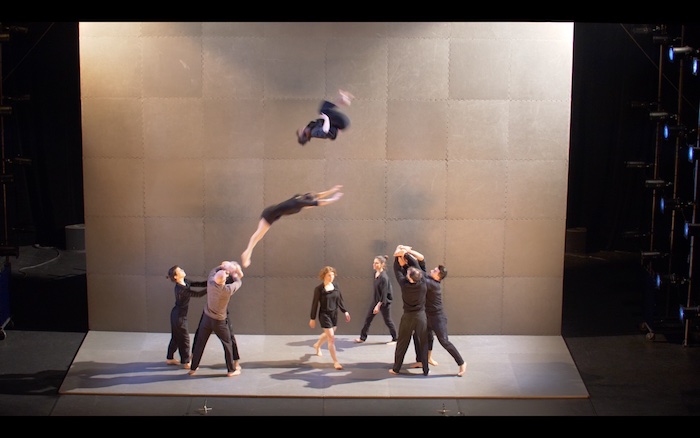Review from: CIRCa Festival, Auch; October 2022
This review was written as part of a module on the BA Circus degree at SKH. You can read more student reviews from CIRCa here.
The purpose of the review is to give a sense of the experience of Barrières by Company Bêstîa, and reflect on the strengths and weaknesses of the show. The review is aimed towards an audience familiar with circus.
Narratives are made compelling by limitations, obstacles, and antagonists, in their absence there is nothing push against nothing to conquer. The show Barrières by Company Bêstîa seems to capture that notion literally. Hung at the back looming over the stage is a gray wall. Through the show the wall changes; it is impenetrable and then deconstructed, it collapses and then is reborn. The audience looks on as a cast of ten acrobats and contortionists, directed by Wilmer Marquez, move propelled by their relationship to the wall responding to its boundaries and attempting to reshape them.
Limitations and edges are something those with a circus practice are continually conscious of, as such it has been reflected upon in performances before. However, Barrières was successful in capturing a new element of limitations, through imagery, changing the audience’s notion of spatial boundaries.
Resting in straps, body horizontal to the floor in straps one of the artists is raised up, then suspended, her feet against the wall she begins to walk. On hands extended above the base’s head, flyers are carried past her, going motions of walking on the newly defined floor. The limits of gravity fall away, space shifts, and suddenly the audience finds themselves upside down watching the pedestrians from above.
Barrières‘ imagery is only achievable through the performers’ virtuosity. It is an incredible display, performers aware of one another, bodies overlapping, stacking in perpetual motion. They mirror each other as they crash through space, anticipating each other blindly. In circus often there is an understanding that the spectacle of risk is simulated, but here, in an air of insecurity the audience holds their breath as it becomes apparent the trust the performers must share as they push their limits together.
There were instances in Barrières that felt disconnected. The show contained such a breadth of material and it felt as though not all of it received the same care.
There is a scene where the artists stack pieces of the broken wall to create a platform. One by one, they climb onto the platform for just a moment till the others pull them down again to reabsorb into the group. Their energy builds until one of them, now standing above the rest, screams. Cutting through the noise, he seemingly establishes his ownership over the stack. Then the attention is redirected to the other cast members who begin to curl up together in a small box at the center of the stage they constructed from pieces of the wall.
Without prompting, the artist on top of the stack climbs down, squeezing into the box with the rest of the cast, completing the final picture of the show. The moment he screams seems to shift his relationship with the rest of the cast, however, that is left unresolved for this the final picture. This instance captures a disjointed sense that punctuates Barrières, permeating scenes that sometimes feel undetermined or purely transitional.
There is a certain irony that a show that proposes the power of limits extends itself too far. However, in its sum, Barrières is a captivating and fast-paced show. One that shares with its audience disorienting imagery and the thrill of pushing the boundary of human capabilities. And, once it is over, a wonder will linger with the audience as they leave, turning away from the stage with its wall still standing.



